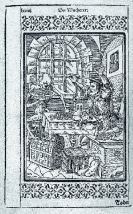Dictionary


Dance of Death
The Dance of Death , French and English also "danse macabre", is represented in painting, prints and mural paintings (more rarely), especially in the Middle Ages. People of both sexes, of varying age, social class (estate) and profession are depicted doing round dances along with corpses or skeletons. In later representations of this kind, a personification of Death replaces the skeletons, primarily as the Grim Reaper with the scythe and hourglass as attributes. The aspects of the transience of life and the inevitability of death as well as the equality of all men in the face of death can be represented very dramatically. The Dance of Death as a genre illustrates the levelling aspect of death, before whom all are equally impoverished. Rich and poor, good and evil alike are haunted by death. In medieval society especially, which was based on the differences between the estates (classes), the suggestion that justice will invariably follow was of enormous importance. It implies, apart from the transience of the individual's own life and fame, an appeal to live as God wills since a person might be called away from life at any time to proceed on the way to Heaven or Hell and, in so doing, also spend time in limbo (Purgatory). The oldest danse macabre representations known are from France and Germany and date from the early 15th century. Many have survived only in copies. Among the famous Dance of Death representations are the Basel cemetery mural (1437-41, only preserved in fragments of a replica) and the Dance of Death in the Marienkirche in Lübeck (1463), which presumably dates from a plague epidemic. The question of how the danse macabre motif originated has, however, remained one of the most controversial issues of late medieval iconography. Some important poems (usually accompanying illustrations) and danses macabres set to music have been produced in our time. Modern book illustrations dealing with the danse macabre theme are by Alfred Kubin, HAP Grieshaber and Horst Janssen.
The Dance of Death , French and English also "danse macabre", is represented in painting, prints and mural paintings (more rarely), especially in the Middle Ages. People of both sexes, of varying age, social class (estate) and profession are depicted doing round dances along with corpses or skeletons. In later representations of this kind, a personification of Death replaces the skeletons, primarily as the Grim Reaper with the scythe and hourglass as attributes. The aspects of the transience of life and the inevitability of death as well as the equality of all men in the face of death can be represented very dramatically. The Dance of Death as a genre illustrates the levelling aspect of death, before whom all are equally impoverished. Rich and poor, good and evil alike are haunted by death. In medieval society especially, which was based on the differences between the estates (classes), the suggestion that justice will invariably follow was of enormous importance. It implies, apart from the transience of the individual's own life and fame, an appeal to live as God wills since a person might be called away from life at any time to proceed on the way to Heaven or Hell and, in so doing, also spend time in limbo (Purgatory). The oldest danse macabre representations known are from France and Germany and date from the early 15th century. Many have survived only in copies. Among the famous Dance of Death representations are the Basel cemetery mural (1437-41, only preserved in fragments of a replica) and the Dance of Death in the Marienkirche in Lübeck (1463), which presumably dates from a plague epidemic. The question of how the danse macabre motif originated has, however, remained one of the most controversial issues of late medieval iconography. Some important poems (usually accompanying illustrations) and danses macabres set to music have been produced in our time. Modern book illustrations dealing with the danse macabre theme are by Alfred Kubin, HAP Grieshaber and Horst Janssen.
Offers




